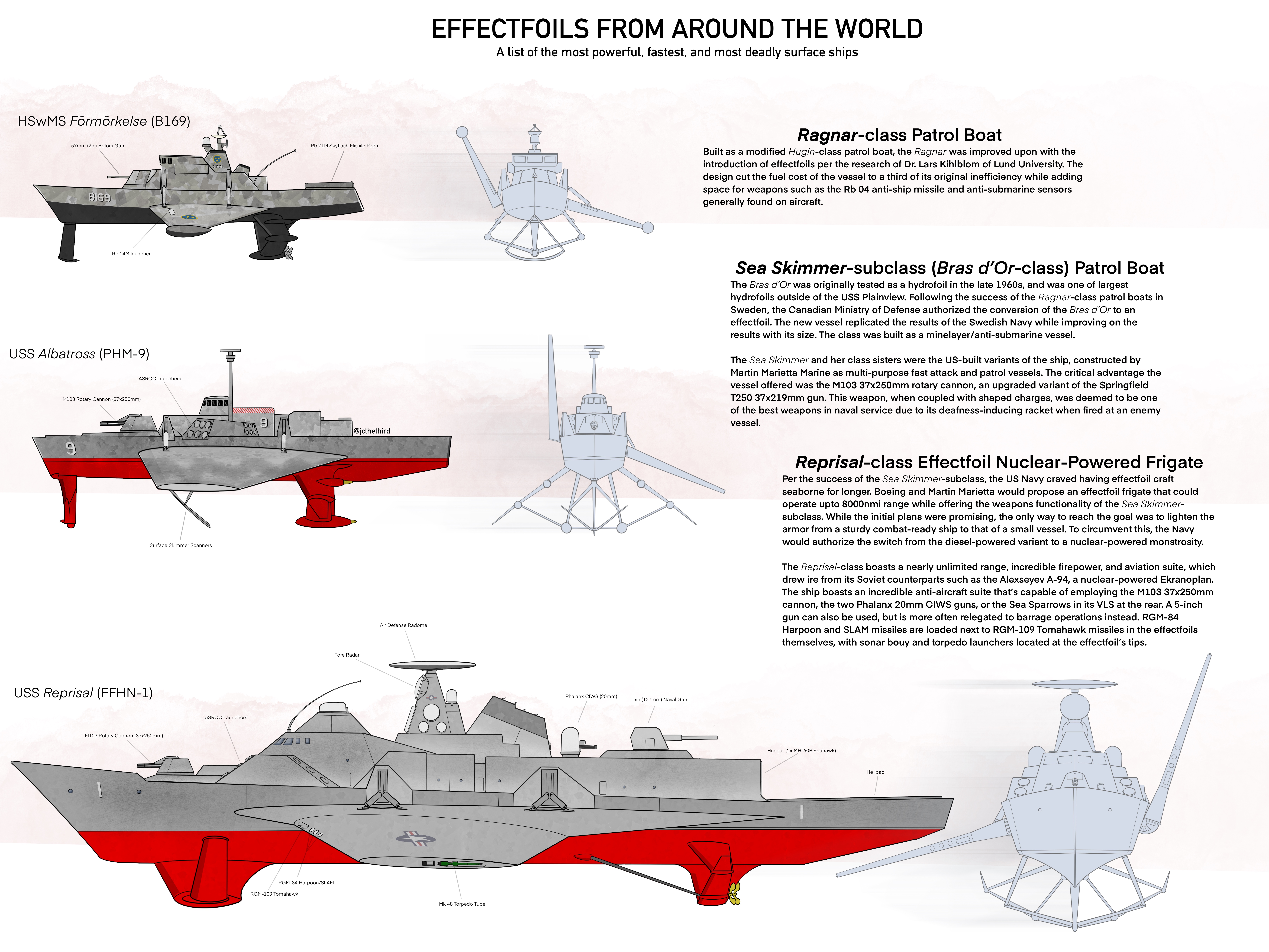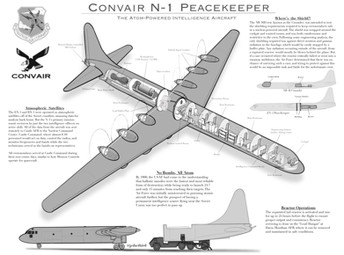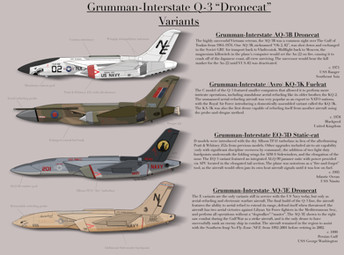HOME | DD
 jcthethird — Effectfoils of the World
jcthethird — Effectfoils of the World

#hydrofoil #ship #ships #skimmer #sweden #us #ekranoplan #groundeffect #patrolboat #effectfoil #wing_in_ground_effect #ground_effect #gatlinggun #navy
Published: 2022-06-29 03:00:53 +0000 UTC; Views: 8504; Favourites: 119; Downloads: 35
Redirect to original
Description
Note: this is a fictional what-if scenario. Upon doing my research, I wanted to make the wings better to actually have value as intended, but I was already too far along. Basically these boats would need foils as proportionally spanning as a Cessna wing.
==Effectfoil==
An Effectfoil (sometimes referred to as a Glidefoil) is a type of aerofoil wing specifically designed for operating in Ground-Effect. The term is also used to describe ships that rely on effectfoils for operation. While originally referred to as a aerofoil, the term was transitioned following the Canadian Navy's conversion of the [[Bras d'Or-class Effectfoil Minelayers/Patrol Boats|Bras d'Or-class Minelayer]], choosing to identify the vessel differently than the Ragnar-class Effectfoil Patrol Boats, which was often referred to as a "Glidefoil" by outsiders (Swedish nomenclature referred to the vessel as a Markeffektfartyg, which translates to "Ground Effect Ship").
==Bras d’Or Class==
The '''Bras d'Or-class''' is a class of [[Effectfoil]] type vessels developed by the Royal Canadian Navy for minelaying and anti-submarine roles. Originally built as hydrofoils, the vessels were upgraded to effectfoils in the early 1970s following the success of the Swedish-built [[Ragnar-class Effectfoil Patrol Boats]]. A number of the vessels were ordered and manufactured domestically by the United States for patrol roles and anti-aircraft operations.
=
The Bras d'Or was originally constructed as a one-off research vessel, initially inteded on being an anti-submarine minelayer, but later converted to be an unarmed patrol vessel intent on rapid surveying of the vast Canadian coasts. While the vessel was impressive in its role, the issue with its fuel consumption limited its success. By 1970, it was clear that the Bras d'Or program was nearing the end and that the vessel would likely be retired rather than upgraded and expanded upon.
In 1969, the Swedish Navy would tout their greatest innovation in Naval technology. The [[Ragnar-class Effectfoil Patrol Boats|HSwMS Ragnar]], the first of her class of patrol boats, was unveiled. Featuring a hydrofoil propulsion system, the ship showed slight improvement over existing hydrofoil designs with no performance boost. But when the vessel was tested with a pair of [[Effectfoil|effectfoils]], the vessel's range tripled, the speed increased, and the engine was able to run at a lower throttle setting. Demonstrations of the new ship showcased the vessels additional missilepower in its effectfoil, which made it capable of taking on far larger ships than most existing patrol boats could.
Canada, seeing the possibility of a second life for their Bras d'Or design, licensed the Kihlblom design from [[Scania Aero|Scania]], allowing them to redevelop the Bras d'Or as an effectfoil.
===Conversion===
The Bras d'Or would undergo the conversion from 1972 until 1974, at which point it would reenter service as a weaponized warship, complete with a single 57mm gun and a minelaying suite at the rear.
The tests were so successful that the Canadian Navy ordered an additional 3 for construction.
===Sea Skimmer-subclass (US Navy variant)===
In 1976, the US Navy began eyeing their own possible effectfoil craft for coastal defense operations. While the USS Plainview hydrofoil design was the most likely vessel for the conversion, the ship had proven to be problematic and labor-intensive. While the preferable action was to build and design their own version domestically, the Canadians were seeing enormous success with the Bras d'Or, and the ship was being touted as the most impressive vehicle built in the 1970s. In late 1978, the Navy announced their plan to contract-build a number of licensed Bras d'Or-class vessels for the US Navy.
In order to meet the desired needs of the Navy, the vessel was to be redesigned as an anti-ship, anti-aircraft, and anti-submarine patrol boat, having the minelaying functionality being removed for improved weight balance. Designs were drafted by Martin Marietta, with construction of the vessels beginning in 1982 in Gary, Indiana. When the USS Sea Skimmer (PHM-7) would launch, it was temporarily unarmed, as the ship's weapons were being tested.
When the main gun was installed, it was a shock to most in the maritime world. The US Navy had opted for the [[Springfield Armory M103 Rotary Cannon]], a 37mm Gatling Cannon originally designed for anti-aircraft operations. The advantage that the gun had was the ability to fire multiple new rounds versus the 30mm Avenger, including armor-piercing, depleted uranium, high explosive, white phosphorus, flak, and incendiary. These rounds, coupled with the Springfield Armory rangefinding computer and spread-controlling actuators, enabled for a nearly perfect weapon for rapidly eliminating close-range threats. A set of Sea Sparrow pods and ASROC launchers were also added for further defense and offensive capabilities.
While initially planned to carry RGM-109 Tomahawk launchers in the effectfoil, these were scaled back in favor of the RGM-84 Harpoon anti-ship missile.
==Operational History==
The Canadian Bras d'Ors saw extensive patrol service with the Royal Canadian Navy, including a brief stint supporting Australia during the [[Oceanic War]]. While the Canadian vessel never fired a shot in war, it did see engagements against pirates off of the Somalian and Indonesian coasts, where the Bras d'Or-class would quickly defend itself with its gun. The anti-submarine functionality proved very successful, with the Bras d'Ors locating and intercepting over 190 submarines of the Soviet and Chinese Navy before the end of the Cold War.
===US Service===
The Sea Skimmer-subclass vessels of the US Navy would demonstrate highly successful operations during the bombing of Libya and the Tanker War. As part of the Tanker War, the USS Albatross (PHM-9) would land some of the most damaging blows on Iranian Navy vessels in the Indian Ocean, managing to sink 2 destroyers by itself. The ship also would shoot down one Iranian F-4 Phantom that had entered the no-fly zone the US had established.
A pair of the Sea Skimmer-subclass vessels were employed during the Gulf War to help hunt the [[Wonsan-class Submarine#Iraq |Gilgamesh]], a Wonsan-class ballistic missile submarine of the Iraqi Navy.
The Sea Skimmer-subclass has no immediate replacement, mainly due to its nearly unscathed hull which enabled it to continue service until today. Due to range limitations, the US Navy would pursue the [[Reprisal-class Effectfoil Frigates|Reprisal-class]], a pair of nuclear-powered effectfoil frigates which required almost no refueling when in service.
==Ships==
*HMCS Bras d'Or
*HMCS Bonaventure
*HMCS Manitoulin
*HMCS Akimiski
===Sea Skimmer-subclass===
*USS Sea Skimmer (PHM-7)
*USS Sea Breaze (PHM-8)
*USS Albatross (PHM-9)
*USS Waverider (PHM-10)
*USS Riptide (PHM-11)
[[Category:Ships]]
==Reprisal-class Effectfoil Frigate==
The '''Reprisal-class Effectfoil Frigates''' are a pair of nuclear-powered, [[Effectfoil|effectfoil]] frigates built for the US Navy for long-ranged fast attack and support on the open oceans. Built towards the end of the Cold War, both vessels saw extensive service during the Gulf War and subsequent [[Eastern European War]].
=
Following the US Navy's implementation of the [[Bras d'Or-class Effectfoil Minelayers/Patrol Boats]] as Patrol boats, the Navy showed great appreciation for the newer vessels impressive range over standard hydrofoils. As a result, the Navy began looking to capitalize on this with their own development of a ship that could operate alongside their existing fleets at sea while helping both scout and protect their ships without requiring a refuel every 2000 miles.
===CLGH/CLHN/FFHN Program===
In 1978, the US Navy drew up the confidential CLGH program, an Effectfoil Light Cruiser project intent on putting a guided-missile cruiser at the front of the fleet. In order to meet the requirements, the vessel needed to be 180m long, capable of reaching 72 knots, and could reach ranges of 3,500 miles before a refuel was necessary. Initially planned on being powered by diesel turbines, the Navy would opt for nuclear-power when efficiency would require less weight aboard the vessel. To accommodate the change, the program became the CLHN program.
As research progressed, the Navy decided to scale the design down to allow them to employ existing nuclear reactors and turbines already in place for cruisers rather than move up to aircraft carrier sized reactors. The CLHN program was scaled-down to a frigate-class, now known as a FFHN program, at least until the project proved that larger ships were feasible.
===FFHN Program===
Now confidentially designated as a plan in 1983, the Navy pressed on with overengineering the vessel for the role it was to assume. Over the next three years scale models, computer engineering, subassembly tests, and armor battery tests were completed by the Navy at various locations around the US. Shipbuilding engineers performed "Open-face tests" of the gun, power, and electrical systems in Bath, Maine, where the FFHN was to be built.
===Construction===
The hull for FFHN-1 was laid down in mid-1986 at the Bath Iron Works, with the propulsion unit being installed relatively quickly afterwards in order to allow for propulsion tests in-hull. Secrecy was maintained by suggesting that a new submarine was destined for the nuclear powerplant while the ship itself was to be Perry-class Frigate replacement. In later-1986, the hull for the FFHN-2 was laid down one dock over. The name "Reprisal" was chosen in March of 1987, in honor of the USS Reprisal, a Revolutionary War blockade runner brig.
On July 2, 1987, the Reprisal was launched publicly, revealing her designation and hydrofoil build for the first time, from Bath Iron Works and began undergoing her sea trials. During the trials, the effectfoils were revealed to contain RGM-109 Tomahawk launchers, RGM-84 Harpoon tubes, and Mark 46 torpedo tubes on the tips, as well as a vast array of sensors and anti-submarine drogues. For deck-mounted armament, the vessel was fitted with a turreted [[Springfield Armory M103 Rotary Cannon]], a 37mm chain-gun successor to the T250 self-propelled anti-aircraft gun, as well as a 127mm Mk 45 turreted gun, RIM-7 Sea Sparrow launchers, ASROC anti-submarine rocket pods, and two Phalanx CIWS gun systems on either side of the exhaust port. A hangar at the rear allowed for up to two UH-60 Seahawk helicopters, which could be deployed when the vessel was in hull propulsion mode. In testing, the vessel impressed the Navy and Department of Defense, with both claiming that it was the most powerful vessel ever created, with virtually no predators shy of ballistic nuclear strike. The Soviet Navy feared the ship, mainly for its speed and advanced sensors, which could detect and harass Soviet submarines before they could detect the hydrofoil.
On January 8th, 1988, the Reprisal entered service as FFHN-1. The Revenge (FFHN-2) was commissioned on March 1st, 1988.
==Operational History==
Both vessels would frighten the Soviet Navy mercilessly when they entered service. Thanks to the powerful anti-submarine sensors on the effectfoils' tips, a Soviet submarine would be detected long before the submarine detected the effectfoil approaching. Coupled with an arsenal fit for a full-sized missile cruiser, the Reprisal-class offered a monsterous presence whereever it was. Following the fall of the Soviet Union, Admiral Feliks Gromov, who later became the Commander-in-Chief of the Russian Navy, would remark that the Reprisal-class was the most feared weapon of the war. After nearly 79 submarine intercepts in the short period of service during the Cold War, the Soviets had determined that there was no possible way a submarine could defend itself against the vessel. Furthermore, the radar-guided 37mm M103 gun ensured that any approaching aircraft was minced before a payload could be dropped or fired, the Phalanx guns eliminated all of the incoming weapons effectively, and any broadside impact was likely to cause no damage, as the angled wings mitigated or deflected all projectiles and protected the weakest compenent, the propeller shafts. In combat, the 37mm gun could carry high-explosive, armor-piercing, anti-aircraft, and depleted uranium rounds, which would eliminate every shore-based defense or battery with a short burst. Any conventional artillery gun or mortar fire could easily be evaded by the vessel using its speed and turn radius, allowing it to zig-zag its way through enemy fire that wasn't deliberately attempting to blanket the area in front of the Reprisals. The 127mm gun was useful, but was far superceded by the newer weapons that graced the ship's deck.
===Gulf War===
The Reprisal and Revenge were dispatched together from New York and arrived in the Gulf 9 days later, just 2 days before the beginning of Desert Storm. During the War, the ships were used to launch 49 of their Tomahawks against the Iraqi country, as well as a number of their Harpoons against Iraqi and captured-Kuwaiti vessels. During the fight, the Revenge claimed a Xian H-6 bomber that was attempting to skim over the water to attack US vessels in the center of the Persian Gulf, with the aircraft being brought down by the M103 gun in a harrowing display of destruction. Following the conflict, the USS Reprisal and Revenge had cemented themselves as the deadliest vessels of the conflict.
===Special Forces Deployment===
The Reprisal and Revenge have been widely used by the US Navy as Special Forces deployment vessels, often being fitted with a SEAL team and AURA (Attack-Utility-Reconnaissance-Aviation) helicopter unit for clandestine operations.
Related content
Comments: 9

👍: 1 ⏩: 1

👍: 1 ⏩: 0

👍: 1 ⏩: 1

👍: 0 ⏩: 1

👍: 0 ⏩: 0

👍: 1 ⏩: 1

👍: 1 ⏩: 0

👍: 4 ⏩: 1

👍: 1 ⏩: 0
























